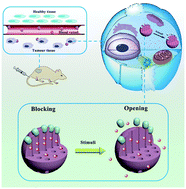Diverse gatekeepers for mesoporous silica nanoparticle based drug delivery systems
Abstract
Conventional cancer chemotherapy is often associated with toxicity issues. Thus, new drug delivery systems (DDSs) are developed as alternatives owing to their potential to selectively target affected cells while sparing normal tissues. Among them, noninvasive and biocompatible mesoporous silica nanoparticle (MSN)-based targeted DDSs have developed rapidly. In particular, controlled gatekeepers capping the pore entrances of MSNs play prominent and crucial roles in achieving specific drug release and avoiding premature leakage in the delivery process before the target is reached, and perfect gatekeepers can only be removed under specific internal or external stimuli, such as pH, redox potential, temperature, biomolecules, light, magnetic field and ultrasound, or a combination of these stimuli, which is significant for precise therapeutic treatments and potential applications in human bodies. Thus, the main focus of this review is to highlight the most recent progress on the design of various controlled MSN gatekeepers to achieve ‘zero premature release’ drug delivery. The diverse gatekeepers are categorised into the following kinds according to their types and characteristics: (1) polymers; (2) inorganic nanomaterials; (3) host–guest assemblies; and (4) biomacromolecules. This review will offer a broad palette of opportunities for researchers with interests including nanomaterial fabrication and modification, targeted drug delivery and stimuli-responsive drug release.



 Please wait while we load your content...
Please wait while we load your content...